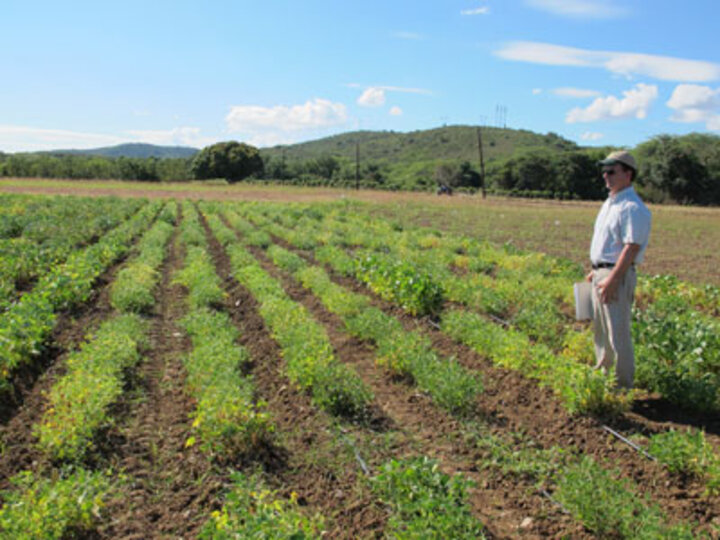May 18, 2012
When UNL Dry Bean Breeding Specialist Carlos Urrea arrived at the UNL Panhandle Research and Extension Center near Scottsbluff in 2005, western Nebraska was in the middle of its worst drought in decades. The drought and water allocations from natural resource districts limited the amount of water often available for production agriculture in the Panhandle.

This is why breeding new dry edible bean cultivars that are more tolerant to drought and heat is one of the main objectives of Urrea’s program.
Dry bean germplasm lines with drought tolerance, in addition to disease resistance, and seed quality, are being developed simultaneously in western Nebraska and Puerto Rico as part of a “shuttle breeding project.’’ Urrea is cooperating with the USDA Agricultural Research Service Tropical Agricultural Research Station (USDA-TARS) at Mayaguez, Puerto Rico.
New dry bean lines are being grown at Scottsbluff and at the University of Puerto Rico in Fortuna. The advantage of this arrangement, he explained, is that he and his colleagues can select for multiple traits in different locations: some traits at one of the sites, other traits at the other site. Then the lines from both sites can be combined.
Urrea selected Puerto Rico because of its warmer climate. He is working with Tim Porch of USDA to develop beans adapted to both Puerto Rico and western Nebraska. Results so far have included the release of two black-bean germplasm lines with heat and drought tolerance in addition to resistance to multiple diseases (common bacterial blight, root rot, and bean common mosaic virus). Germplasm also has been released that can be used for different bean breeding programs in the United States. And Urrea said there will be more lines to come in different market classes: great northern, pintos, and small reds.
Perhaps some of those lines have the potential to be released to the public as cultivars. But before that is known, Urrea said, new lines would need to be tested on a larger scale, in growers’ fields.

In addition to heat and drought tolerance and resistance to several diseases, Urrea said these new lines also would need several other desirable traits: an upright plant architecture to facilitate direct combine harvest; high seed quality; and maturity traits that would fit growing conditions in western Nebraska.
Urrea visited the bean breeding site at Puerto Rico early in 2012 and is impressed with the lines selected this year.
Another goal of this project is to find and mark the genes responsible for drought tolerance. Urrea said he and his colleagues have developed a mapping population of dry beans between tropical and temperate lines that was tested last year and will be tested again this year at both locations. This project is in collaboration with the U.S. Department of Agriculture at Prosser, Wash., (Phil Miklas), USDA-TARS at Mayaguez, PR (Tim Porch) and North Dakota State University (Juan Osorno and Angela Linares).
Urrea recently attended an Association Mapping Workshop at North Dakota State University hosted by the BeanCAP. He was learning how to employ molecular markers (single-nucleotide polymorphisms, or SNPs in scientific terminology) generated by the BeanCAP to uncover genomic regions associated with drought tolerance. About 10,000 SNPs have been developed by the BeanCAP.
The sources for this mapping population included dry bean lines from the CIAT Center for Tropical Agriculture and from National Dry Bean Breeding Program in Mexico, Urrea said. He said the the source of drought tolerance that he is using for mapping was identified through testing on terminal drought (when irrigation is stopped at the flowering stage of plant development). Nature has cooperated in this effort; in each of the past several years. After the irrigation was stopped, precipitation also was scarce, with less than 1 inch of rain between blossom stage and harvest each year. Those conditions make life difficult for dry bean producers, but are favorable for Urrea’s research.
Using dry bean lines from the Center for Tropical Agiculture not only helps with the drought tolerance project, but also has other benefits to the breeding program, Urrea said. Every year, he introduces new lines coming from CIAT, some from specific crosses between different common bean (Phaseolus vulgaris) species like tepary and scarlet runner beans. In doing so, he has been able to identify some lines that are well adapted to western Nebraska’s conditions and drought, and started intergressing those into his dry bean breeding program through hybridization.
The goal is to develop dry edible beans that will use water more efficiently, and perhaps use less water.
One potential benefit: if bean producers don’t need as much water to raise their bean crop, they might be able to use some of the available supply for other crops on their farms, Urrea said.
Urrea and other U.S. bean breeders also are looking at how drought affects the nutritional composition of dry beans. About 96 accessions from different centers of origin and domestication were screened in 2012 under drought and non-drought stress plots. This research is part of BeanCAP (Coordinated Agricultural Programs) efforts and includes several other states, including Michigan, North Dakota, Washington and Idaho.
David Ostdiek, Communications Associate
UNL Panhandle REC, Scottsbluff
